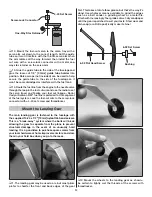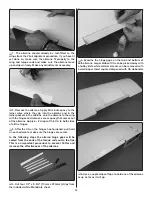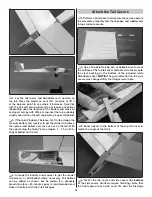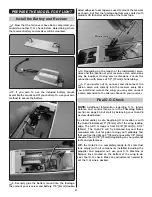
33
❏
3. Finally, make one last check to be sure all the controls are
responding in the correct direction—same as a conventional
tail, the ruddervators should move up with up elevator stick
input and move right with right rudder stick input.
Basic Checklist
Perform these basic checks before heading out to the fi eld:
❏
Receiver battery charged
❏
Servo mounting screws present and tight
❏
Servo wheel/arm retainer screws present and tight
❏
Fuel tank secure
❏
Engine and muffl er bolts tight
❏
C.G. check
❏
Throws check
❏
Control response direction
❏
Failsafe set
❏
Spare parts:
❏
Glow plugs
❏
10-24 nylon landing gear screws
❏
Propellers
CAUTION:
Monitor the threads in the wing bolt plates
each time you mount the wing to the fuselage to make
sure they are strong. If there are ever signs of the
threads breaking down, reinforce them with epoxy or
CA and re-tap the threads.
ENGINE SAFETY PRECAUTIONS
Failure to follow these safety precautions may result
in severe injury to yourself and others.
●
Keep all engine fuel in a safe place, away from high heat,
sparks or fl ames, as fuel is very fl ammable. Do not smoke
near the engine or fuel; and remember that engine exhaust
gives off a great deal of deadly carbon monoxide. Therefore
do not run the engine in a closed room or garage
.
●
Get help from an experienced pilot when learning to
operate engines.
●
Use safety glasses when starting or running engines.
●
Do not run the engine in an area of loose gravel or sand;
the propeller may throw such material in your face or eyes.
●
Keep your face and body as well as all spectators away
from the plane of rotation of the propeller as you start
and run the engine.
●
Keep these items away from the prop: loose clothing,
shirt sleeves, ties, scarfs, long hair or loose objects
such as pencils or screwdrivers that may fall out of shirt
or jacket pockets into the prop.
●
Use a “chicken stick” or electric starter to start the engine.
Do not use your fi ngers to fl ip the propeller. Make certain
the glow plug clip or connector is secure so that it will
not pop off or otherwise get into the running propeller.
●
Make all engine adjustments from behind the rotating
propeller.
●
The engine gets hot! Do not touch it during or right after
operation. Make sure fuel lines are in good condition so
fuel will not leak onto a hot engine, causing a fi re.
●
To stop a glow engine, cut off the fuel supply by closing
off the fuel line or following the engine manufacturer’s
recommendations. Do not use hands, fi ngers or any
other body part to try to stop the engine. To stop a
gasoline powered engine an on/off switch should be
connected to the engine coil. Do not throw anything
into the propeller of a running engine.
Range Check
Don’t forget to perform a ground range check as written in
the instruction manual that came with your radio system
to be certain it is operating correctly.
AMA SAFETY CODE (
EXCERPTS
)
Read and abide by the following excerpts from the Academy
of Model Aeronautics Safety Code. For the complete Safety
Code refer to
Model Aviation
magazine, the AMA web site
or the Code that came with your AMA license.
General
1) I will not fl y my model aircraft in sanctioned events,
air shows, or model fl ying demonstrations until it has
been proven to be airworthy by having been previously,
successfully fl ight tested.




































